When it comes to survival situations, every advantage you can give yourself counts, especially when it comes to catching food.
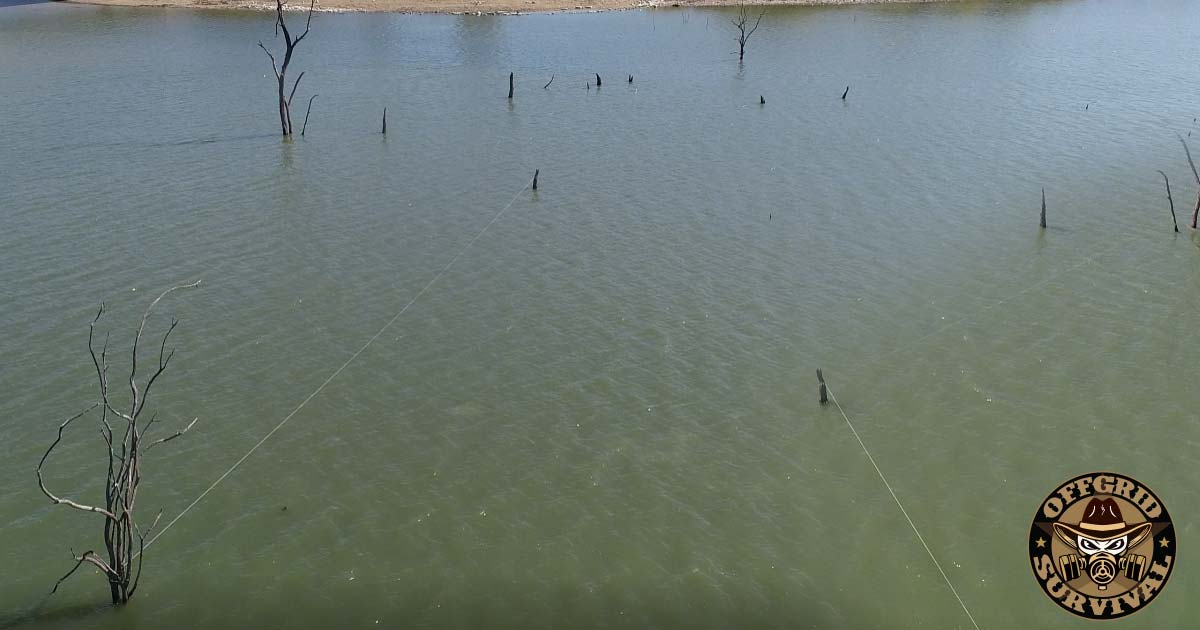
Enter the mighty trotline – a clever fishing system that allows you to maximize your chances of landing a lot of fish without constantly monitoring your line or expending a lot of energy and effort. It’s a time-tested technique that can make all the difference in a survival situation, and we’re about to dive into the details of this ingenious fishing method. So, get ready to learn how to set up a trotline and increase your chances of a successful catch, even in the most challenging circumstances!
What is a Trotline?
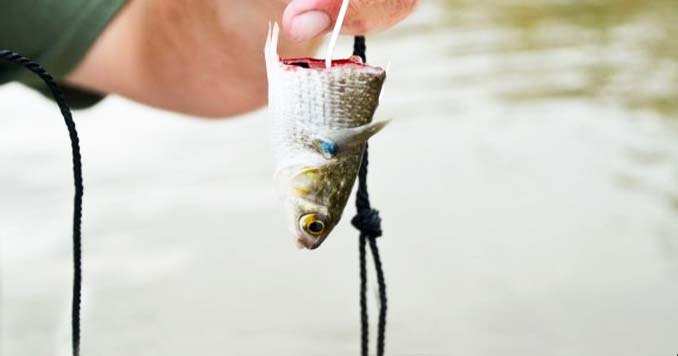
A Trotline is basically a long line or rope, with a number of smaller lines (known as trots, snoods or droplines) attached to the main line with either swivels or knots. The droplines have hooks and are baited for whatever fish you are going after – in most cases probably catfish.
The thing I like about this style of fishing, is you can use a trotline to completely cover the width of a river, stream or creek; giving you a good chance of catching passing fish. In a survival situation, we call this a passive method of gathering food, because once it’s set you can move on to other important survival-related tasks while the trotline works for you 24/7.
You can set your trotline out in the morning, and then check it in the evening – or vice versa.
While these can be set up as passive traps, to really get the most out of your trotlines check them every couple of hours. This gives you the opportunity to rebait empty hooks and allows you to catch even more fish.
History of the Trot Line
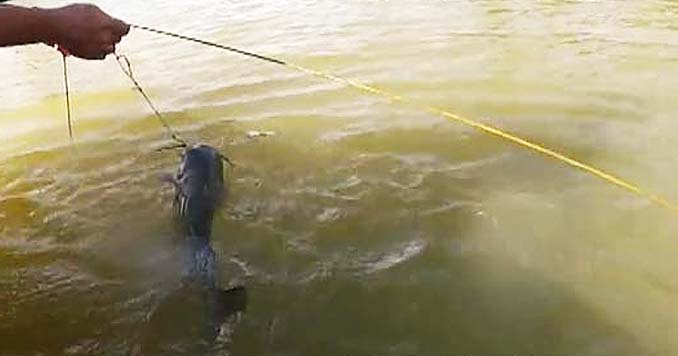
Trotlines have a rich history that spans back centuries, with evidence of their use dating back to ancient civilizations such as the Egyptians and the Chinese. These early fishermen used primitive forms of trotlines made from natural materials like plant fibers and animal sinews to catch fish from rivers, lakes, and oceans.
Over time, these setlines evolved and became more sophisticated. In medieval Europe, trotlines made from horsehair were commonly used, and they were even mentioned in historical texts and folklore. As fishing techniques advanced, trotlines were made from different materials, such as modern-day fishing lines and hooks, and are used in various environments around the world, from the icy waters of Scandinavia to the warm shores of the Caribbean.
This age-old technique has been a staple of traditional fishing practices in the South for generations, passed down through the years as a reliable way to harvest fish from rivers, lakes, and coastal waters. In the Southern United States, trotlines are commonly used to target popular fish species such as catfish, crappie, and bass. Many Southern anglers rely on trotlines as a dependable method to provide a fresh catch for their families, especially in rural or remote areas.
Trotlines are typically set up with multiple hooks attached to a main line, which is anchored in place and left in the water for a period of time, allowing the fish to be caught passively. One of the key benefits of trotlines is their versatility. Depending on the target fish species and the fishing environment, they can be set up in different configurations, such as stretched across a river or hung from a dock. Trotlines can also be customized with various baits, lures, and hooks to attract specific fish, making them a flexible and adaptable fishing method.
What can you catch on a Trotline?
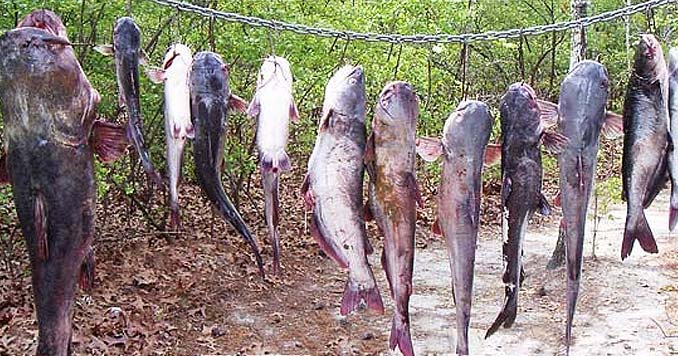
Trotlines are especially effective when trying to catch almost any kind of catfish. While catfish is your most likely catch, you can catch just about any type of fish using these lines, and they can even be an effective way of catching turtles and crabs.
This type of fishing is extremely effective and versatile. In fact, many, Blue Crab fisherman run a variation of a trot line where the mainline is completely anchored to the floor, allowing the crabber to work large areas of water without a lot of effort.
Survival Fishing Hacks: How to make a Trotline for Fishing
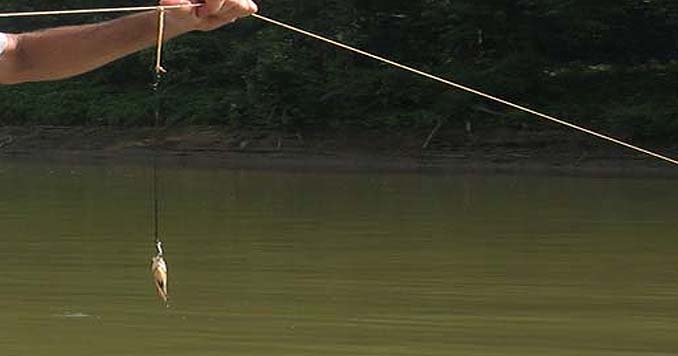
Building a trotline is actually pretty simple. During a non-survival situation, I often build them using basic supplies like paracord for the main line and swivels with an attached braided dropline and a baited hook. During a survival situation, you can use whatever you have.
Making a trotline requires some basic fishing gear and materials. Here’s a step-by-step guide on how to make a simple trotline:
Alright, first things first! You’ll need some basic fishing gear for making a trotline.
- Mainline: Grab a strong and durable fishing line, preferably nylon or polypropylene, about 100 to 200 feet long.
- Drop lines: Shorter lines (about 2-3 feet each) attached to the mainline at regular intervals, usually spaced about 3-5 feet apart, with a swivel or clip on the end for attaching hooks and bait.
- Hooks: Choose appropriate hooks for your target fish species, such as circle hooks or J-hooks.
- Bait: Select bait that is attractive to the fish species you are targeting, such as worms, cut bait, or live bait.
Set Up the Mainline. Next, scout out a good location along the waterbody where you want to set up your trotline. It could be a river, a dock, or a spot near some trees.
If you’re heading to a sprawling lake or reservoir, look for a couple of trees jutting out from shallow waters. Your trotline should be long enough to span the distance between the trees. On the other hand, if you’re targeting rivers and creeks, you’ll need to consider the fishing spot. Catfish tend to gravitate towards shallow flats adjacent to deeper waters, and these flats may only run along the bank for short distances. In such scenarios, a shorter trotline could suffice. However, if you’re looking to go all out and span bank to bank, a longer trotline will be necessary.
Once you’ve determined the appropriate length for your trotline, the next question is how many hooks you should tie. The general rule of thumb is to have a hook every six feet. This allows for good coverage without the risk of hooks tangling when a hooked catfish puts up a fight. However, it’s important to check the regulations of the lake and state you’ll be fishing in, as there may be limits on the number of hooks allowed on a trotline. Additionally, most states require trotlines to be properly tagged with identification to indicate ownership, so be sure to comply with these requirements.
Assembling your trotline is a breeze once you have all your materials ready. Start by tying your mainline between two trees, and then attach your 24-inch drop line to the mainline every six feet. Once the droplines are secured, go ahead and attach the swivels and hooks to them. Some people prefer using two swivels per dropline, while others opt for just one – the choice is yours to make. Once everything is in place, wind up your trotline and you’re ready to hit the water. If time allows and you’re fishing in less populated areas, you can also assemble your trotline at the actual location. Simply tie off the mainline, attach your drop lines and hooks, and bait as you go.
To ensure your trotline sinks to the bottom, you’ll need to attach weights. Almost anything can work as a weight, from rocks to coffee cans filled with cement. Tie enough weights to your trotline to achieve the desired depth. Typically, a heavy weight is placed in the middle with several others distributed on either side. Keep in mind that the more weight you have, the more effort it will take to check your trotline as you’ll be pulling up additional weight from the depths of the water. Keep in mind catfish are bottom feeders.
Let’s talk catfish. These slippery critters have some interesting behaviors that can give you an edge when setting up your trotlines. One thing to keep in mind is that catfish are attracted to the scent of food, and they’re not afraid to swim against the current to get to it. So, if you want to increase your chances of a big catch, try setting your trotlines in areas with a decent current. That way, the aroma of your bait will travel downstream and entice catfish from long distances downstream. And don’t forget to keep an eye out for spots where fresh water enters a larger body of water, like a creek joining a lake after a heavy rain. These can be catfish hotspots with a virtual buffet of food for them to feast on. Knowing these little tricks can make all the difference in your fishing success!
Baiting a trotline in a river requires a slightly different approach compared to baiting a line in a lake. Rivers can have strong current flows, which can affect the effectiveness of your bait. Personally, I find that live bait works best in rivers when targeting larger species like spotted catfish or blue catfish. There’s just something about the wriggling and splashing of live bait that seems to drive those big cats wild! Cut-bait and shrimp are also effective options in rivers. In fact, I’ve had some great success using cut-bait and shrimp as well.
Another trick I like to use in rivers, especially when fishing in flooded timber, is live crawfish. These little critters can be irresistible to hungry catfish lurking in those submerged woody hideouts. So, depending on the river conditions and the type of catfish you’re targeting, you may want to consider using live bait, cut-bait, shrimp, or even live crawfish to bait your trotline. It’s all about experimenting and finding what works best for the specific fishing conditions and catfish in your area.
List of trotline supplies
You can find premade trot lines at almost any fishing store, or even these on Amazon, but I like to build my own so I know they are spaced right and so I know my mainline can handle the possibility of pulling up a huge haul without snapping under the weight of all those fish. If you are targeting monster flatheads or blues, you want to build your own line.
- 550 Paracord: I usually choose some type of Paracord for my main line. First, it’s cheap, second, it can handle a lot of weight -550 pounds to be exact. You can also buy it in gigantic 1,000-foot spools allowing you to have more than enough line to build multiple trotlines.
- Droplines: For the droplines I usually like to use a roll of Hard Nylon Line or some really thick ass 75+ pound braided line.
- Big Eye Circle Hooks. Your droplines are probably going to be thicker than your average fishing line, so you want to sue a hook with a big eye that allows you to run a thicker diameter line through the hook.
- Some type of Weight: You are going to need something to weigh your lines to the floor of the water, but don’t worry about spending all sorts of money on this. An old paint bucket filled with cement will do the trick!
Building your lines:
When attaching your droplines, you want to space them out so the fish can’t get tangled up with other fish or lines. That means the spacing between lines should be about 12-18 inches longer than the dropline. In areas with strong currents, I sometimes add weighs to keep the line from surfacing. Once the line is set, I typically only check it once or twice per day.




Hey Robert,
something that I always have im on of my vehicles is a good pellet rifle. I have mine zeroed in so that I can shoot something the size of a quarter at about 100 feet. I do not think a pellet rifle gets enough press. As you know, every bird on this continent is edible. Also, a good Gamo 175 pellet traveling at over 1000fps wiil take all kinds of small game. Also, properly trained, a pellet rifle can take out a human to at least the point of them leaving you the hell alone. I have the Whisper model in 175 cal. and the shotgun model in 22 cal. and the shotgun shells are cool as hell and work very well. The shot shells are a little expensive though. Other advantages are that they do not attract much attention as well as noise goes in the woods. I personally would not want to go camping or fishing without my trusty old pellet rifle.
Robert Floyd
I agree. A good pellet rifle can feed you pretty easily and fairly discreetly.
TKS totally agree with yea..Here in Canada, it’s difficult to purchase weapons but so needed to be fully prepared especially in scenario such as “pole shift”..big cities huge problem..anyways just wanted to say thanks for the tips although, here we cannot purchase weapon as easy as US, we can however, purchase hunting guns..something I’m gonna start real soon.
Also, BB guns with metal ammunitions works quite well too, like you say, leave us alone kinda scenario, those little BB guns they’re quite powerful too..tks again! Sylvie, Toronto, On Canada
I realize this may be an older thread, but to continue Roberts point….keep a slingshot handy. They’re REALLLLY cheap, and you can pick up ammo while you’re walking along.
I have some pictures of a sling shot variation I made from some idea’s off youtube. It will allow you to shoot arrows from your sling shot. Ive done some small game hunting and after some trial and error figured out how to shorten the bands to the maximum tension. I haven’t tried it on large game yet, but Im getting `12-15 inches of penetration with field heads on a shot block, and a grouping with some practice of about 4 inches at 10-15 yards. I believe you could take down larger game animals like deer, and elk if you had to. It would probably be effective as defense for large predatory animals in a pinch. It can be fired a lot faster than any compound bow Ive ever shot before. If you want some pictures of it, send me your email and I’ll send some pics.
can you send me the pics for the slingshot modifications
thanks
I would love to see the modifications.
Would love to see the pics and any measurements you have. Thanks
I have many different options for self defence and hunting, however…I am always interested in new or different things…..so i would very much like to see a pic of the sling shot.
you wouldn’t happen to be talking about Dave Canterberry’s sling-bow would you? If so give credit where credit is due.
Please send pic and info
Would like to see that info and pix!
I would like to see pics. of that slingshot
Thanks
Thanks JMCD sounds cool, yeah show me your modification I’m fair with a sling shot
never shot arrows though sounds fun. Could you send me some pictures of the set up &
the size arrows and kind of arrows you hunt with.
Check out this guy .He is on youtube.The slingshot man from NC. My dad told me about him local slingshot legond from our area.
I would be very interested in seeing the slingshot modifications you made that allow you to use it for launching arrows.Thank you!(please note my E-mail address is:william hardee cross,FOLLOWED BY 3 LOWER CASE L’S TO DENOTE I AM THE THIRD,and..@hotmail.com)or:williamhardeecrosslll@hotmail.com
I agree and also recomend the bottle trap.
1.cut the bottle in half and put the bose inwards.
2.slip the bait into the back of the bottle.
the fish will go in through the nose and wont be able to come out again.
its simple,cheap and effective.
Saw a hunting show not to long ago. Gamo rep was shooting 88ld-188lb hogs one shoot between the eyes they drop like rocks. I have one and they do kick ass.
I think thats a good idea it would be wiser to use it in a stream but it would work in a creek. i have caught catfish and bass like that and even a turtle.
I love bottle traps for crawdads! They are good eating! Think baby lobster tails. Pellet guns are WAY under rated,I have a crosman 1000,aside from having to cock it,I love it!
Great points made here. My kit usually includes several different tools for fresh meat. Be it fish, fowl, or flesh. Sling Shot, Tout Line, various hooks, and snare wire (about 100 ft)and a full spool of 25lb test. I’ve found the water bottle trick to be wonderful for not just crawdads, but excellent for catching minnows. Even though this article was intended on fishing, the pellet gun is grossly under rated. Birds and small game are easily taken, the ammo is cheap, and it’s quiet. I’d stay away from the CO2 versions, as it requires more junk in the trunk and once they’re gone, there’s no Wally World for refills and once a cartridge is installed, it’s used. Weather you shoot or not.
Great tip on stream lining! Too bad the BIG GOV was up our ass with fish and game laws.
hey northern survivalist: guess what?in a shth case the gov. rules and regulations are not really to important since there will be no one to enforce them. stream lines,traps, nets,even explosives are fair game.and forget seasons and limits.when it comes to feeding my family the sportsman rules don,t count
i have wilderness hike/camped mountains, deserts, snow, coasts, swamps, all that u.s.a. has to offer. now that websites, books,videos, dvds, etc. are available we all have a chance. we must learn to make do with less. aboriginals do it with style. the people around us are our biggest threat. they can go beserk. they can eat us when shtf. do not leave a trace behind, have many ways out, small dakota fires, no smoke. just like the “matrix”, our system/control is beyond corrupt/dangerous, and the people cling to it for dear life. trust god/all good spirit, pray always for guidance/hunches; trust them. learn survival techniques/practice in the field. the time may be closer than you think. love the planet, god, yourself, people, but; cast off baggage, your life depends on it. remember history, the holocaust, war for money, christians in the coliseums; we can be vicious cold-blooded folks. i don’t mean to be gloomy or radical, i love living as a aboriginal. it frees my mind, my beliefs, my soul. i pray we smarten-up as a people and fly right; but i also want to be happy and live to be old and free. never give up and bless you all. dave.
Good article, this is a variation of a trot line. The state I live in allows up 100 hooks per trotline. You can attach the mainline to a tree limb also. The tree set works best with just one hook and the bait just below the water. The spring action of the tree limb plays the fish and there are few lost.
A blowgun is a good option. I’ve used one in the past and it was very quiet and didn’t disturb other wildlife in the area.
I think the leftist lamestream media is using exactly this same method to track the gullible and easily led
Sorry – meant “trick”
Along with the trot line idea is using the Yo-Yo fishing tool.
It works great! Simply add some line to the end of the Yo-Yo line. add a hook with bait. Attach the Yo-Yo tool to the shore or an overhanging branch. The Yo-Yo is equiped with a spring that simply reals the fish back in after it stops swimming hard.
These Yo-Yo tools are only a couple of dollars each and so you could set up a great trot line or attach some lines at the edge of the water.
So glad to hear that, I have equipment for the multi-line approach, but have been wondering about the Yo-Yo’s. Glad to hear, will get a few.
Would like to see the pics of that sling shot., please
Nice ill have to try it is this illegal
This idea is ok but i think you need to hide these kind of things. a stick drove in the water so it is under the water. you run 550 cord down stream 100 feet to a rock. Attach 20 inch fishing lines along it with hooks and bait for the type of fish you are going after. I like spiderwire braid. set lines for turtles, water foul etc also work if u know how to do it. snaring a beaver from the enterance of its house is very easy. as trapping a muskrat from inside its house in the winter. these animals are easy winter meat. where hunting is not. Deer can also be caught by the leg with a spring pole. These trapping techniques will put meat on the table faster than hunting, are concealable. and you can hunt as you check your traps.
looks like a trotline built by city folks.
Another thought I might have would be that If you have a mosquito net, you could also use that to corral fish into a small space where you can just scoop them out.
Used trotlines a lot of times. works great. something else that is a little more time consuming but works great is a fish corral. Just drive sticks into the water in a circular design, leaving an area large enuf for the fish to swim in. as you go begin to make a conch shell form with a wide area in the center. the fish swim in and can stay as long as you want them to. you have to leave a little space ( about an inch to inch and a half between sticks so the water can flow thru, and food can get to the fish. Used this a few times and works great.